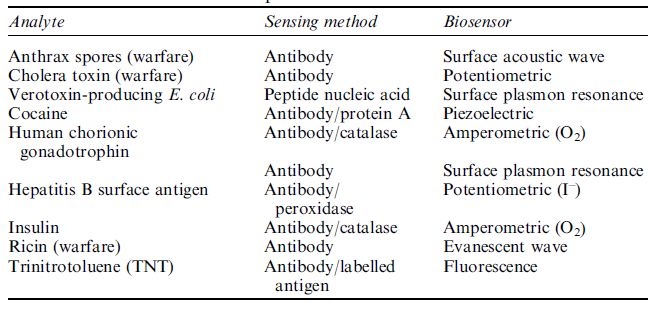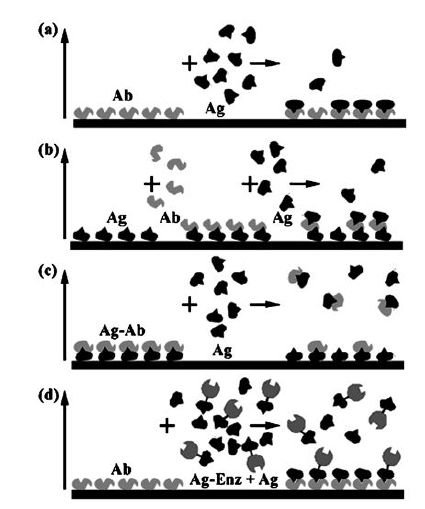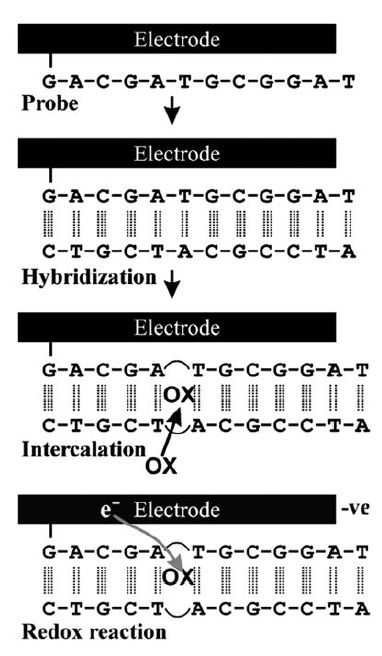


 النبات
النبات
 الحيوان
الحيوان
 الأحياء المجهرية
الأحياء المجهرية
 علم الأمراض
علم الأمراض
 التقانة الإحيائية
التقانة الإحيائية
 التقنية الحيوية المكروبية
التقنية الحيوية المكروبية
 التقنية الحياتية النانوية
التقنية الحياتية النانوية
 علم الأجنة
علم الأجنة
 الأحياء الجزيئي
الأحياء الجزيئي
 علم وظائف الأعضاء
علم وظائف الأعضاء
 الغدد
الغدد
 المضادات الحيوية
المضادات الحيوية|
Read More
Date: 16-1-2021
Date: 22-12-2020
Date: 16-12-2020
|
Receptor-Based Sensors
Receptor-based sensors include immunosensors (Table 1.) and some of these have been mentioned earlier. Most biosensor configurations may be used, with Figure 1. showing some of those possible. Direct binding of the antigen to immobilised antibody (Figure 18.17a) or antigen–antibody sandwich (Figure 1.b) may be detected using piezoelectric or SPR devices,as can antibody release due to free antigen (Figure 1.c). Binding of enzyme-linked antigen (Figure 1.d) or antibody can form the basis of all types of immunosensors but has proved particularly useful in amperometric devices. The amount of enzyme activity bound in these receptor-based sensors is dependent on the relative concentrations of the competing labelled and unlabelled ligands and so it can be used to determine the concentration of unknown antigen concentrations.
Table 1. A selection of receptor-based sensors.


Figure 1. Different configurations for biosensor immunoassays: (a) antigen binding to immobilised antibody; (b) immobilised antigen binding antibody which binds free second antigen; (c) antibody bound to immobilised antigen partially released by competing free antigen; (d) immobilised antibody biding free antigen and enzyme-labelled antigen in competition.
The main problems involved in developing receptor-based sensors centre on non-specific binding and incomplete reversibility of the binding process, both of which reduce the active area and hence sensitivity, on repetitive assay. Single-use biosensing membranes are a way round this but they require strict quality control during production.
DNA chips have been produced that contain tens of thousands of different but known single-stranded polynucleotides immobilised on a silicon chip. Thus, fluorescently labelled single-stranded DNA can be probed for structure due to the specificity of DNA–DNA binding.
Introduction of redox materials that can intercalate between doublestranded DNA, but not bind to single-stranded DNA allows the development of electrochemical versions of these chips without the need for fluorescent probes or fluorescence readers (Figure 2.). A simple example involves ferrocene-linked naphthalene diimide.

Figure 2. DNA biosensor. Binding of the complementary strand allows certain redox molecules to intercalate into the DNA fragment to allow detection via amperometry.
Proteins, such as antibodies, may also be attached to DNA chips by means of covalently attached complementary probes, so allowing thousands of differently binding proteins to be specifically attached to single chips. The high negative charge on the complementary linkers almost totally removes the chance of non-specific binding. This area is likely to expand considerably over the next few years.



|
|
|
|
اكتشاف تأثير صحي مزدوج لتلوث الهواء على البالغين في منتصف العمر
|
|
|
|
|
|
|
زهور برية شائعة لتر ميم الأعصاب التالفة
|
|
|
|
|
|
موكب أهالي كربلاء يستذكر شهادة الإمام الصادق (عليه السلام)
|
|
|
|
العتبة العباسية تستذكر شهادة الإمام الصادق (عليه السلام) بإقامة مجلس عزاء
|
|
|
|
أهالي كربلاء يحيون ذكرى شهادة الإمام الصادق (عليه السلام) في مدينة الكاظمية
|
|
|
|
شعبة مدارس الكفيل النسوية تعقد اجتماعًا تحضيريًّا لوضع الأسئلة الامتحانية
|